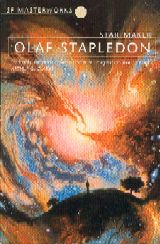Star Maker
Star Maker is a science fiction novel of prodigious scope, or work of speculative philosophy, by Olaf Stapledon1 (1937). Unlike its predecessor, Last and First Men, it presents a panoply of intelligent alien life across the Galaxy with each race striving toward the common goal of achieving "a more awakened state." The physical repositories of intelligence prove to be astonishingly diverse and Stapledon's human protagonist encounters sentient arachnoids, nautiloids, echinoderms, fish-like creatures, plant men, and many others. All these species, however, are ultimately engaged in the same struggle: to evolve to new levels of mental capacity, a progression which Stapledon overtly equates with spiritual development. Only a tiny minority of civilizations survive the "familiar crisis" now facing modern man, achieve a well-organized, utopian world-order, and evolve to become part of a growing community of linked minds. Over vast epochs of time, individual creatures and races, and even planets, stars, and galaxies, expand in consciousness and merge telepathically until, in the far future, the Universe as a whole becomes aware – and aware of its creator, the Star Maker. Thus Stapledon arrives at a scenario strangely reminiscent of that envisaged, decades later, by the more enthusiastic proponents of the anthropic principle. Moreover, his imagination is broad enough to encompass numerous universes, each with subtle variations, some sterile, others with life, again presaging late 20th century thought on this issue (see chaotic inflationary theory and many-worlds hypothesis).
Star Maker's influence, and that of its predecessor, are difficult to gauge or overestimate. Arthur C. Clarke and C. S. Lewis are just two of the many writers who continued, in different ways, its cosmic quest for truth using a variety of extraterrestrial life-forms as players. Less obviously, the entire SETI movement represents, in a sense, a Stapledonian attempt to make contact with a cosmos-wide community of intelligence and so enable mankind to become an integral part of a larger adventure.
 |
Reference
1. Stapledon, Olaf. Star Maker. Los Angeles: Jeremy P. Tarcher (1987).


